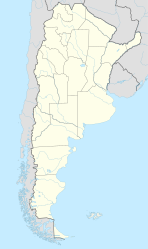Río Gallegos
|
Río Gallegos ñn |
|||
|---|---|---|---|
| City and provincial capitalñ | |||

San Martín Avenue
|
|||
|
|||
| Nickname(s): ñlll | |||
| Location of Río Gallegos in Argentina | |||
| Coordinates: 51°38′S 69°13′W / 51.633°S 69.217°WCoordinates: 51°38′S 69°13′W / 51.633°S 69.217°W | |||
| Country | Argentina | ||
| Province | Santa Cruz | ||
| Department | Güer Aike | ||
| Founded | 19 December 1885 | ||
| Founded by | Ramón Lista | ||
| Government | |||
| • Intendant | Roberto Giubetich | ||
| Elevation | 20 m (66 ft) | ||
| Population (2010) | |||
| • Total | 97,742 | ||
| Time zone | ART (UTC−3) | ||
| CPA base | Z9400 | ||
| Dialing code | +54 2966 | ||
| Climate | BSk | ||
| Website | Official website | ||
Río Gallegos (Spanish pronunciation: [ˈri.o ɣaˈʃeɣos]) is the capital and largest settlement of the Patagonian province of Santa Cruz in Argentina. Located in the department of Guer Aike, it has a population of about 98,000, according to the 2010 census [INDEC], a 24% increase from the 79,000 in the 2001 census [INDEC]. The city bears the name of the Gallegos River, and sits on its estuary 2,636 km (1,638 mi) south from the Argentinian federal capital Buenos Aires.
Established on 19 December 1885 to increase Argentine power over southern Patagonia, Río Gallegos became the capital of the then Territory of Santa Cruz in 1888, retaining its status when the territory became a province in 1957. Nestor Kirchner, later President of Argentina, served as the city's mayor from 1987 to 1991 and is interred in a mausoleum in the city's cemetery.
In 1525 Spanish explorer García Jofre de Loaísa became the first European to reach the Gallegos River, and named it Río San Idelfonso. Simón de Alcazaba y Sotomayor's 1535 expedition was the first to name the river "Río Gallegos". The area was not settled by Europeans until much later, with the settlement established 19 December 1885, when the Argentine government wished to better express its sovereignty over southern Patagonia — a naval base was created which increased the development of the town. Between 1912 and 1920, the government encouraged settlers from the Falkland Islands (Spanish: Islas Malvinas) and southern Chile with preferential farming conditions. Some 3,000 arrived and boosted the town. As sheep-farming increased, Río Gallegos became the principal port for exporting sheep and their products. The Pioneers Museum is a preserved old Patagonian house exhibiting the life of the early settlers.
...
Wikipedia



